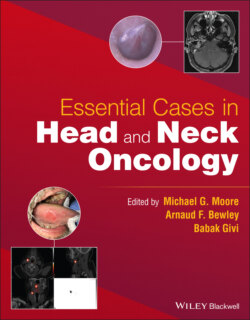Читать книгу Essential Cases in Head and Neck Oncology - Группа авторов - Страница 19
Management
ОглавлениеQuestion: What would you recommend next?
Answer: Since the lesion has been present for more than 2 weeks and a significant history of tobacco and alcohol abuse exists, tissue diagnosis via incisional or punch biopsy is warranted.
Question: The biopsy is performed and shows invasive, moderately differentiated keratinizing SCC. How would you stage this disease?
Answer: The clinical stage of the disease at this point is T2N0M0, stage II. However, the alveolar lesions can invade the mandible early in the process. Therefore, imaging of the mandible to better delineate osseous involvement is indicated.
Question: How would you determine the involvement of the mandible?
Answer: No imaging modality can offer 100% sensitivity and specificity. CT scanning, especially cone‐beam CT, has been utilized as a modality with high sensitivity. Magnetic resonance imaging (MRI) could be useful in determining the involvement of the bone marrow. In the absence of any single definitive modality, attention to the overall clinical exam and imaging findings could guide the clinician to determine the extent of the disease. For oral cavity lesions with suspected mandibular involvement, most surgeons would start with a CT scan with contrast of the head and neck to evaluate the primary site lesion and regional lymphatics.
A PET/MRI and neck CT with IV contrast are obtained. The CT of the neck shows significant thinning of the lingual cortex of the mandible at the site of the lesion and the absence of the buccal cortex superiorly. The inferior alveolar canal appears intact (see Figure 2.2). The PET/MRI shows intense activity at the primary lesion without clear evidence of lymph node metastases. On MRI, there is an abnormal marrow signal at the location of the lesion, suspicious for marrow invasion. There is no evidence of involvement of the mandibular canal.
Question: Based on imaging findings, what is the clinical stage of the disease?
Answer: Since there is radiographic evidence of osseous invasion, the disease is upstaged to T4aN0M0, stage IVa.
Question: What is the recommended course of treatment?
Answer: Oral cavity SCC is primarily treated with surgery, followed by risk‐adjusted adjuvant treatment. In this case, the recommended treatment is composite resection of the lesion with segmental mandibulectomy, selective neck dissection (levels I–III), and reconstruction with microvascular free tissue transfer, such as fibula free flap, to provide the best functional outcome.
The patient undergoes segmental mandibulectomy and selective neck dissection with fibula free flap reconstruction. The final pathology shows a 2 × 1 cm ulcerative SCC of the gingiva with invasion of the mandible. All margins are free of tumor (>5 mm). There is no perineural invasion. There is a microscopic focus of carcinoma present in 1 out of 32 lymph nodes (level Ib node, 2.3 cm) with no evidence of extracapsular extension.
Question: What is the pathologic stage?
Answer: Based on mandibular invasion and nodal involvement, the pathologic stage is pT4aN1M0, stage IVa.
Question: What adjuvant treatment regimen would you recommend to this patient?
Answer: In spite of negative margins and no perineural invasion, advanced T stage and involvement of regional nodes warrant adjuvant radiotherapy. There is no indication for chemotherapy (positive margins and extranodal extension). Therefore, adjuvant radiotherapy is adequate.
FIGURE 2.2 These axial images are from the patient's CT (a, b) as well as the T1‐weighted MRI (c) and fused PET/MRI (d). Note the lesion of the right mandible with associated cortical erosion and hypermetabolism.
